When I imagine a desert landscape, I conjure thoughts of endless sand dunes under a blue sky with a relentless sun beating down. And not much vegetation.
Travelling inland through some of the arid red centre for the first time in 2007, I was shocked at how different the reality was from my imaginings. I still have a very vivid memory of scanning the vista, and I was amazed at all the greenery before me, for miles and miles into the distance. As I explored more of the arid part of Australia on our recent trip, I am no less amazed at how much vegetation occupies our deserts.
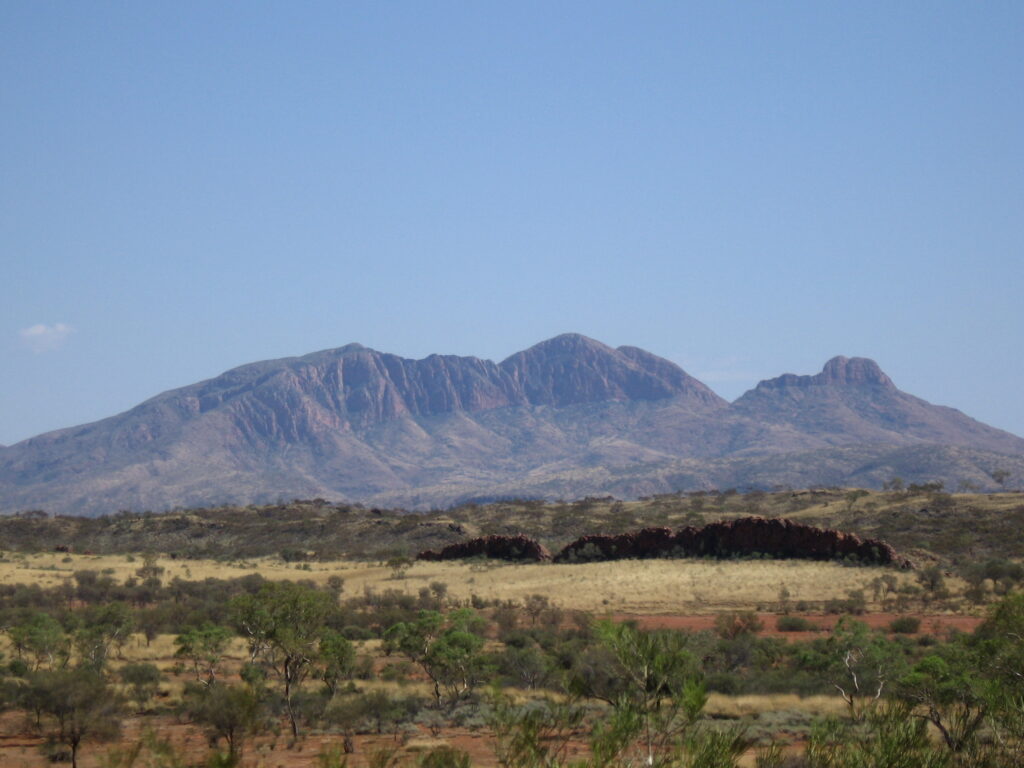
Deserts are found on every continent and cover about one-fifth of Earth’s land area. They are home to around one billion people—one-sixth of the Earth’s population, yet they are often portrayed as extreme places with resident communities marginalised from mainstream development. According to maps and official designations, there are several deserts in the arid interior of Australia. They cover 18 per cent of Australia’s mainland and are home to about 200,000 people.
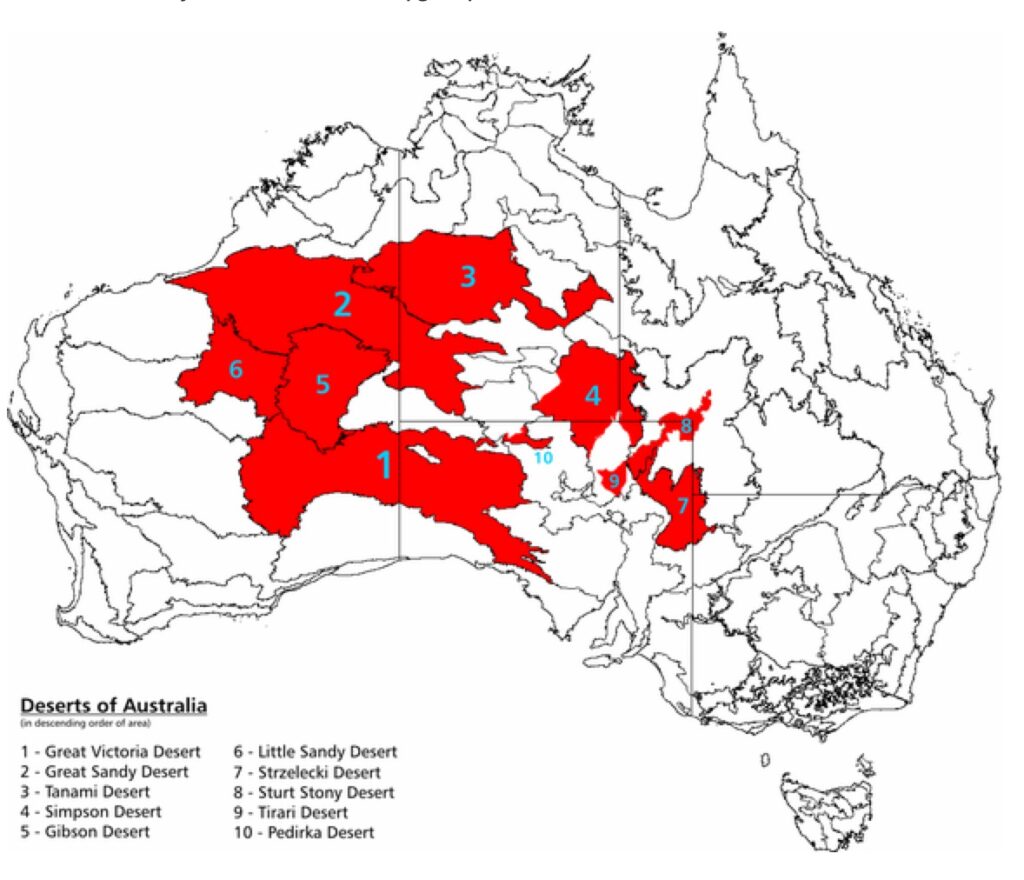
There may be large areas where the height and extent of vegetation are minimal, but they are vegetated. What exactly is a desert and what are the typical features? There are different types of deserts and they have different and varied environments. The common feature is they are arid or dry. Most experts agree that a desert is an area of land that receives no more than 250 millimetres (10 inches) of precipitation a year. Also, the amount of evaporation in a desert often greatly exceeds the annual rainfall. Thus, in all deserts, there is little water available for plants and other organisms.
Desert humidity is usually so low that not enough water vapour exists to form clouds. The sun’s rays beat down through cloudless skies and bake the land. Temperature extremes are a characteristic of most deserts. In some deserts, temperatures rise so high that people are at risk of dehydration and even death. At night, these areas quickly cool because they lack the insulation provided by humidity and clouds.
It is often claimed that Australian plants are adapted to desert conditions. In reality, they are adapted to periodic drought. And droughts are not just confined to arid Australia. In Australia, variability is normal and rainfall patterns are not always seasonal which leads to extreme environmental conditions. The overlying pattern of long dry periods followed by pulses of flooding rain, or boom and bust, is a feature to which plants and animals have become adapted.
So, are Australian deserts true deserts? By international standards, Australian deserts receive high rates of rainfall. No weather station situated in an arid region receives less than 100 millimetres on average a year. It is only after severe droughts or bush fires that they have a desert-like appearance. But why are they considered deserts? One school of thought is that early cattlemen found that most of the interior consisted of featureless infertile sand plains, with few permanent water bodies, useless for cattle grazing and were thus classed as ‘deserts’.

However, I have often wondered if human occupation and their impacts on vegetation cover by altering climatic patterns have created the arid landscape we know today, rather than deserts simply being a function of natural climatic changes. After all, humans transformed the environment in Asia and North America through grazing. The spread of agriculture and civilisations 5,000 years ago adversely affected semi-arid regions in the Middle East and helped spread deserts in Arabia and Central Asia.
Until recently, scientists have attributed the transformation of the world’s most iconic desert, the Sahara, to changes in the Earth’s orbit, which deprived the tropics of sunlight, leading to a reduction in summer rainfall. However, new research from American environmental archaeologist, David Wright, argues that humans played a significant role in transforming the Sahara region in northern Africa from a lush green landscape of lakes, rivers, grasslands and forests into a desert. Wright studied sediment cores and pollen records and noticed a pattern. Wherever the records showed the presence of humans with domesticated animals, there was a change in the type and variety of plants.
Have humans played a role in creating Australian ‘deserts’? After all Australia doesn’t have a history of domesticated ungulates with our First Peoples. Professor Gifford Miller, from the University of Colorado, has carried out extensive research in Australia. He has concluded that landscape burning by Australia’s First Peoples may have triggered the failure of the annual Australian Monsoon some 12,000 years ago, resulting in the desertification of the country’s interior that is evident today.
His study builds on his research group’s previous findings that dozens of giant animal species went extinct in Australia roughly 50,000 years ago. The main culprit is believed to be ecosystem changes caused by human burning, which lead to the alteration of the flora, causing a decrease in the exchange of water vapour between the biosphere and atmosphere. This, in turn, caused the failure of the Australian Monsoon over the interior.
There is geologic evidence that Australia’s interior was much wetter about 125,000 years ago during the last interglacial period. Fossil remains of browse-dependent birds and marsupials indicate the interior was made up of trees, shrubs and grasses rather than the desert scrub environment present today. Although planetary and meteorological conditions during the most recent ice age caused Earth’s major monsoons to waver, all except the Australian Monsoon were ‘reinvigorated’ to full force during the Holocene Period beginning about 12,000 years ago. Although the Australian Monsoon delivers about 39 inches of rain annually to the north coast as it moves south from Asia, only about 13 inches of rain now falls on the continent’s interior each year.
According to Miller, evidence for burning includes increased charcoal deposits preserved in lake sediments at the boundary between rainforest and the interior desert beginning about 50,000 years ago. In addition, many rainforest gymnosperms, plants whose seeds are not encased and protected and are therefore more vulnerable to fire, went extinct at about that time.
Whilst it’s not conclusively proven Australian aboriginal burning practices caused desertification per se, it is likely to have exacerbated natural changes in the climate that led to desertification.
Few people know the arid interior better than Central Australian botanist Peter Latz. Born at Hermannsburg and raised by Arrernte nannies, he has lived and studied the area all his life and is Australia’s foremost authority on desert plants. He has challenged orthodox views centred around the concept of the ‘noble savage’ living in harmony with the environment. He has written about spinifex and fires in the red centre deserts and argues that Aboriginal people dramatically changed the desert landscape to suit themselves. Latz believes that while the desert plants are adapted to fire, the soil isn’t. Where spinifex occurs, there is no soil. Fire – the ‘red devil’ – removes the blue-green algae on top of the soil and protects it from the elements. Once the algae are burnt, the soil is exposed and washes away when the rain falls. That is why he says the spinifex follows the fire in a symbiotic relationship.
The Tanami Desert stretches for thousands of kilometres. It is predominantly sand dunes and spinifex to the north-west of Alice Springs. Latz believes it was shrubland, with patches of tall eucalypt forest on old river drainage channels only a few thousand years ago.
More recent human impacts elsewhere in the world are evident. For example, the deserts of Patagonia in South America are expanding due to desertification caused by overgrazing, deforestation, and over-cultivation. In the 1930s, parts of the Great Plains of North America became a ‘Dust Bowl’ through a combination of drought and poor farming practices. Between 1950 and 1975, the Sahara Desert crept 100 kilometres south.
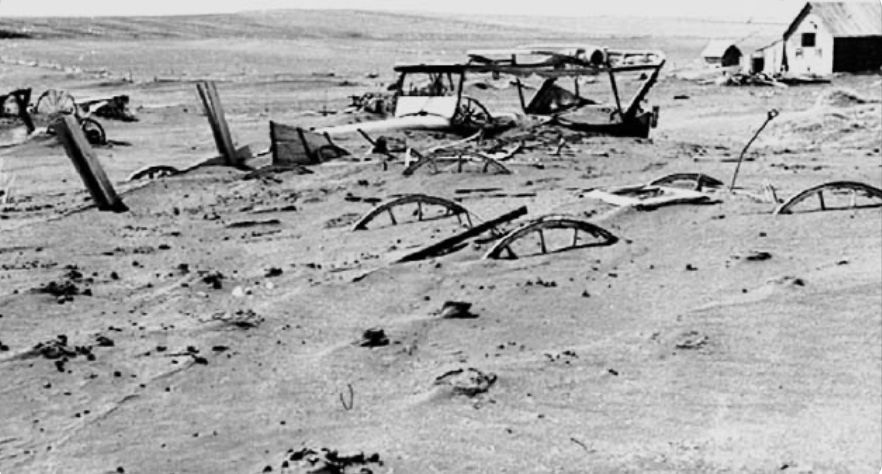
There is an alternate view about deserts and Aborigines in Australia. Aborigines, rather than being a driver of change, learnt to adapt their use of fire in a landscape affected by climate change which was the primary driver of desertification.
Regardless of how ‘deserts’ in Australia were created, the high vegetation levels we see today in arid Australia might be explained through a recent phenomenon. Increased levels of carbon dioxide have helped boost green foliage across regions over the past 30 years through a process called CO2 fertilisation, according to CSIRO research. In findings based on satellite observations, CSIRO, in collaboration with the Australian National University, found that CO2 fertilisation correlated with an 11 per cent increase in foliage cover from 1982-2010 across parts of the arid areas studied in Australia, North America, the Middle East and Africa.
Finally, I want to share with you a recent example of changes in arid Australia caused by direct human intervention. A new study by UNSW scientists has shown how dingoes’ presence – and absence – affects the ‘desert landscape’ in Australia through direct intervention. The Dingo Fence is one of the longest structures in the world, stretching for over 5,000 kilometres across the Australian continent and straddling the borders of South Australia, New South Wales and Queensland. Over the years, the dune fields of the near dingo-free side of the fence have been transformed. Feral fox and cat populations flourished without the competition of a larger predator. The native population of herbivores, such as hopping mice, suffered, and native vegetation cover increased in their absence.[1]
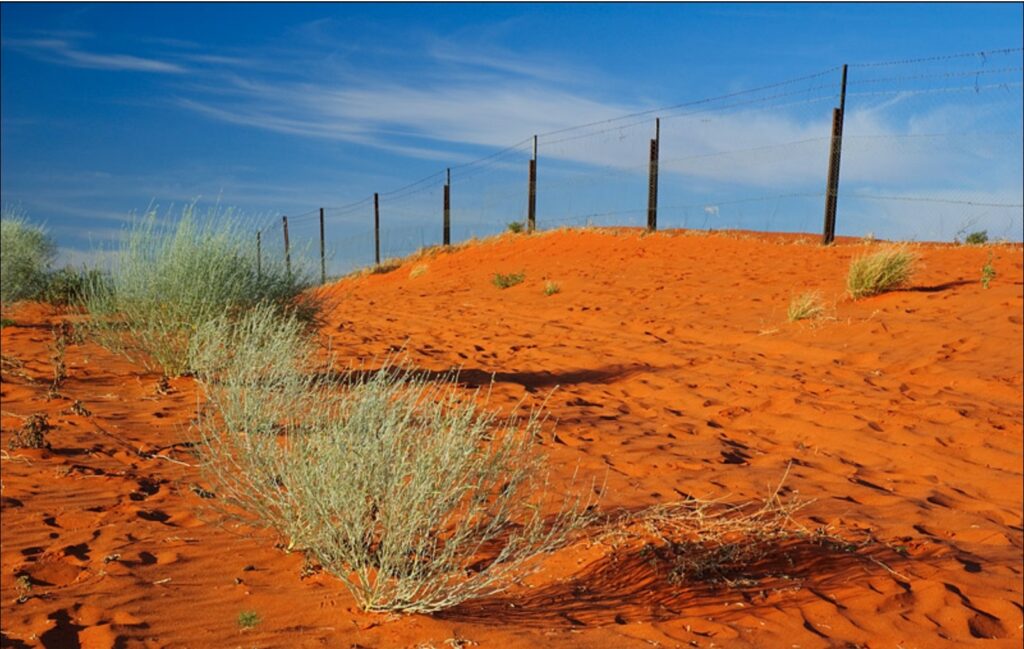
The increased vegetation also altered the patterns of wind flow and sand movement and how the sand settled on the sand dunes. Increased vegetation cover locked down the sand and sediment and allowed the wind to ‘flow’ over the top, creating taller dune peaks. In contrast, on the South Australia and Queensland side of the fence, where dingoes were still present, the dunes were generally ‘flatter’ and not as tall.
Associate Professor Mike Letnic, who led the UNSW School of Biological Earth and Environmental Sciences research team, demonstrated that removing predators can trigger trophic cascades that have far-reaching implications.
If you get the opportunity to travel through arid Australia and you marvel at the landscape in front of you, stop and ponder the thought that what you are witnessing might be a direct result of human occupation for millennia that has contributed to changing climatic patterns, especially rain, and that you are not really in a natural desert.
[1] There is a similar story regarding predator interactions and consequences in the forests east of the Great Dividing Range in New South Wales. South of Barrington Tops, there are few dingoes in the wild and feral foxes and cats flourish. Sadly, as a result, there are few small ground-dwelling native mammals. North of Barrington Tops, there are large populations of dingoes and few cats and foxes. Consequently, there are greater numbers and diversity of small ground-dwelling native mammals. See Catling, P. C. and Burt, R. J. (1994) Studies of the ground-dwelling mammals of eucalypt forests in south-eastern New South Wales: the species, their abundance and distribution. Wildlife Research 21: 219-239; Catling, P. C. and Burt, R. J. (1995) Why are red foxes absent from some eucalypt forests in eastern New South Wales? Wildlife Research 22(5): 535-546; Catling, P. C. and Burt, R. J. (1997) Studies of the ground-dwelling mammals of eucalypt forests in north-eastern New South Wales: the species, their abundance and distribution. Wildlife Research 24: 1-19; Glen, A. S., et al. (2007) Evaluating the role of the dingo as a trophic regulator in Australian ecosystems. Austral Ecology 32: 492-501
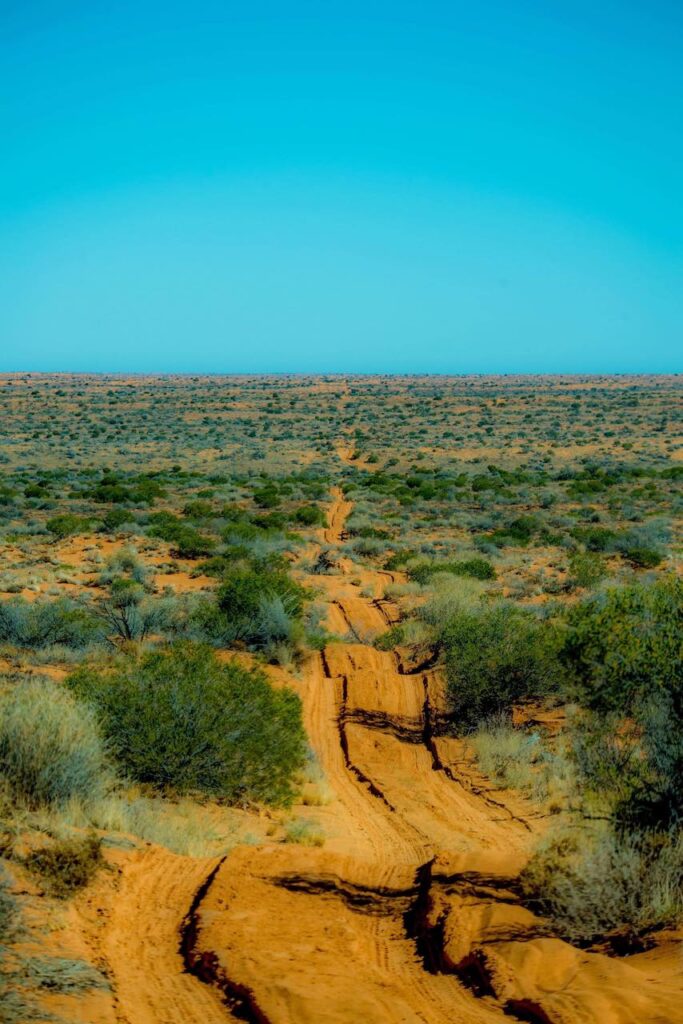
Having travelled with a convoy in 2015 along the Canning Stock Route (taking in parts of the Great Sandy, Little Sandy, Tanami and Gibson deserts), I never once saw Omar Sharif appear out of the haze riding a camel (and there were plenty of those). By any definition, which relies upon credible film footage for support I’d say no, they’re not deserts.
I think they are deserts.